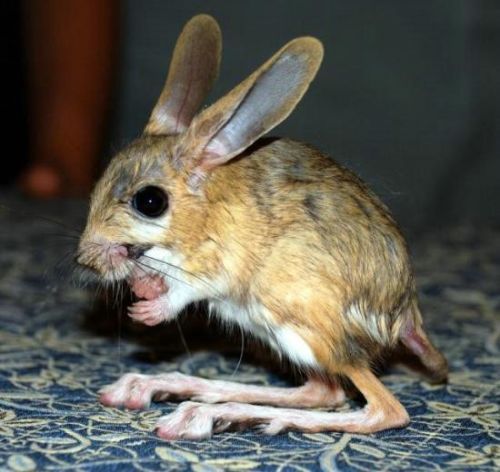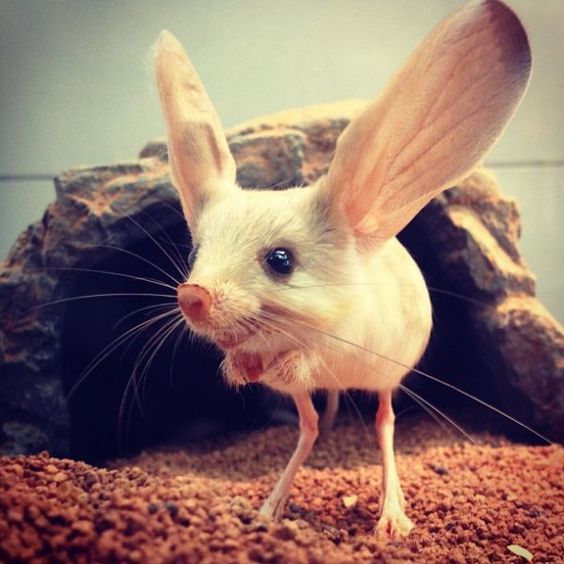The long-eared jerboa is a nocturnal
mouse-like rodent with a long tail, long hind legs for jumping, and
exceptionally large ears. It is distinct enough that authorities consider it to
be the only member of both its genus, Euchoreutes, and subfamily,
Euchoreutinae.
Long-eared jerboas are found in the Palearctic ecozone. The
specific Palearctic ecozone areas they are found in are southernmost Mongolia
to the Takla-Makan Desert, Mengxin, Aerijin Mountain, and Qing-Zang Plateau regions
of north western China. Long-eared jerboas in most cases are nocturnal, the
long-eared jerboa's fur according to the book 100 animals to see before they
die "is reddish yellow to pale russet with white underparts." There
is a long eared Jerboa coin. Very little is known about the species.
Description
The long-eared jerboa's head and body length measures 70 mm
(2.8 in) to 90 mm (3.5 in) while its tail is double this size, between 150 mm (5.9
in) and 162 mm (6.4 in). Like its disproportionately long tail, its hind feet
are also large, helping it to jump high, measuring between 40 mm (1.6 in) and
46 mm (1.8 in). It weighs 24 g (0.85 oz.) to 38 g (1.3 oz.). Long-eared jerboas
usually eat insects. They use sound to locate and capture them by performing
fast leaps into the air. According to animal diversity web "The two
lateral digits are shorter than the three central ones. The central metatarsals
are fused for a small distance. The feet are covered with tufts of bristly
hairs. Long-eared jerboas have ears that are 1/3 longer than their heads. The
incisors are thin and white. A small premolar can be found on each side of the
upper jaw. Females have eight mammae." Their fur is light reddish/brown
with a white underside. Their tails are covered in fine hairs the same color as
their body and have a black and white tuft on the end.
Conservation
The long-eared jerboa was identified as one of the top-10
"focal species" in 2007 by the Evolutionarily Distinct and Globally
Endangered (EDGE) project. In 2007 Zoological Society of London EDGE of
Existence Programme sent a researcher to study human impact on its environment.
The study returned with video footage that has been noted as the "first
time" the creature has been "recorded on camera". This has
helped to start a campaign to protect them.
Similar Animals
Gobi Jerboa
Great Jerboa
Lesser Egyptian Jerboa
Greater Egyptian Jerboa
Habits and Lifestyle
Because these animals live in parts of China and Mongolia
that are so remote, it is hard for scientists to study them, and therefore
there is very little known about this tiny animal. All information about their
social behavior is taken from data about related species. Other jerboas are
primarily nocturnal and solitary, spending the day in the underground burrows
which they have dug, often creating four different types: a temporary, day,
summer burrow for cover when hunting in the daytime, a second temporary burrow
for hunting at night, as well as two permanent burrows: a summer one and a
winter one. Permanent summer burrows are used throughout summer and this is
where the young are raised. Jerboas hibernate in the winter in the permanent
winter burrow. Long-eared jerboas hop like kangaroos, jumping over the sand.
Breeding
Little is known about reproduction in the Long-Eared Jerboa
but it is thought to be similar to other closely related species of Jerboa.
Breeding is likely to begin shortly after their hibernation
period has ended and they are thought to have 2 litters during the summer
months. After a gestation period of 25 - 35 days, it is though they will give
birth to 2 - 6 offspring.
Population
Population threats
The greatest threat to this species is human disturbance to
its habitat. Greater numbers of grazing livestock could be a threat in certain
areas, as are drought and the drying up of water sources.
Population number
According to IUCN, Long-eared jerboa is widely distributed
throughout its range but no overall population estimate is available. Currently
this species is classified as Least Concern (LC) on the IUCN Red List.
Ecological niche
Being insectivorous, these animals affect insect populations
in their range.
Fun Facts for Kids
- Long-eared jerboas catch insects by leaping quickly into the air.
- The large ears of these animals are thought to be an adaptation to the desert. The larger ear surface enables them to cool down their blood and dissipate heat in hot, desert temperatures.
- The jerboa's large ears means that they can hear predators from very far away.
- Long-eared jerboas communicate with each other through vibrations. They also use chemical communication through dust bathing.
- Instead of drinking water, jerboas get all the moisture they need from their food, mostly insects and plants.
- A jerboa has a flap of skin in its nose and hair in its ears to prevent sand entering.
References
https://en.wikipedia.org/wiki/Long-eared_jerboa
http://www.theanimalfiles.com/mammals/rodents/jerboa_long_eared.html
http://animalia.bio/long-eared-jerboa



















No comments:
Post a Comment